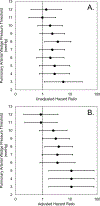Hemodynamic Response to Oral Vasodilator Therapy in Systemic Sclerosis-Related Pulmonary Hypertension
- PMID: 36607535
- PMCID: PMC10666735
- DOI: 10.1007/s10557-022-07420-1
Hemodynamic Response to Oral Vasodilator Therapy in Systemic Sclerosis-Related Pulmonary Hypertension
Erratum in
-
Correction to: Hemodynamic Response to Oral Vasodilator Therapy in Systemic Sclerosis‑Related Pulmonary Hypertension.Cardiovasc Drugs Ther. 2024 Jun;38(3):657. doi: 10.1007/s10557-023-07431-6. Cardiovasc Drugs Ther. 2024. PMID: 36662449 Free PMC article. No abstract available.
Abstract
Purpose: Although classified as group 1 pulmonary arterial hypertension (PAH), patients with systemic sclerosis-related pulmonary hypertension (SSc-PH) experience poorer clinical response to PAH therapy and increased mortality compared to those with idiopathic PAH. Due to heterogeneity in phenotypes, identifying patients likely to respond to therapy is challenging. The goal of this study was to determine clinical factors associated with hemodynamic response, defined by a > 20% reduction in pulmonary vascular resistance on repeat right heart catheterization.
Methods: We applied a time-to-event model using a retrospective cohort of 39 patients with precapillary SSc-PH, defined by a mean pulmonary artery pressure of ≥ 25 mmHg and pulmonary arterial wedge pressure (PAWP) ≤ 15 mmHg on right heart catheterization.
Results: Patients with PAWP ≤ 8 mmHg were nearly fourfold more likely to achieve a hemodynamic response compared to those with PAWP > 8 mmHg (HR 3.88; 95% CI: 1.20, 12.57); each 1 mmHg increase in PAWP was associated with a decreased hazard for hemodynamic response (HR 0.84; 95% CI: 0.70, 1.00).
Conclusion: In patients with precapillary SSc-PH, PAWP was associated with time to hemodynamic response, suggesting the importance of subclinical cardiac disease in determining hemodynamic response to oral vasodilator therapy.
Keywords: Cardiac hemodynamics; Pulmonary arterial hypertension; Pulmonary vasodilators; Scleroderma.
© 2023. The Author(s), under exclusive licence to Springer Science+Business Media, LLC, part of Springer Nature.
Conflict of interest statement
Figures

References
-
- Yaqub A, Chung L. Epidemiology and risk factors for pulmonary hypertension in systemic sclerosis. Curr Rheumatol Rep. 2013;15(1):302. - PubMed
-
- Galiè N, Humbert M, Vachiery JL, et al. 2015 ESC/ERS Guidelines for the diagnosis and treatment of pulmonary hypertension: The Joint Task Force for the Diagnosis and Treatment of Pulmonary Hypertension of the European Society of Cardiology (ESC) and the European Respiratory Society (ERS): Endorsed by: Association for European Paediatric and Congenital Cardiology (AEPC), International Society for Heart and Lung Transplantation (ISHLT). Eur Respir J. 2015;46(4):903–75. - PubMed
-
- Fisher MR, Mathai SC, Champion HC, et al. Clinical differences between idiopathic and scleroderma-related pulmonary hypertension. Arthritis Rheum. 2006;54(9):3043–50. - PubMed
MeSH terms
Grants and funding
- F32 HL156614/HL/NHLBI NIH HHS/United States
- P60 AR047785/AR/NIAMS NIH HHS/United States
- 1UG3 HL143192-01A1/HL/NHLBI NIH HHS/United States
- 1R01HL155955-01A1/HL/NHLBI NIH HHS/United States
- UG3 HL143192/HL/NHLBI NIH HHS/United States
- CCCR P30 AR072571/AR/NIAMS NIH HHS/United States
- U1EMC27864-08-00/HRSA/HRSA HHS/United States
- 1F32HL156614-01/HL/NHLBI NIH HHS/United States
- UL1 TR001430/TR/NCATS NIH HHS/United States
- R01 HL155955/HL/NHLBI NIH HHS/United States
- T32 HL007035/HL/NHLBI NIH HHS/United States
- 2UL1TR001430-05A1/TR/NCATS NIH HHS/United States
- P30 AR072571/AR/NIAMS NIH HHS/United States
- 1F32HL156614-01/HL/NHLBI NIH HHS/United States
- 1R01HL155955-01A1/HL/NHLBI NIH HHS/United States
- 1UG3 HL143192-01A1/HL/NHLBI NIH HHS/United States
- FTF17FTF33670369/American Heart Association
- CCCR P30 AR072571/AR/NIAMS NIH HHS/United States
- 2UL1TR001430-05A1/TR/NCATS NIH HHS/United States
- U1EMC27864-08-00/HRSA/HRSA HHS/United States
LinkOut - more resources
Full Text Sources
Medical

